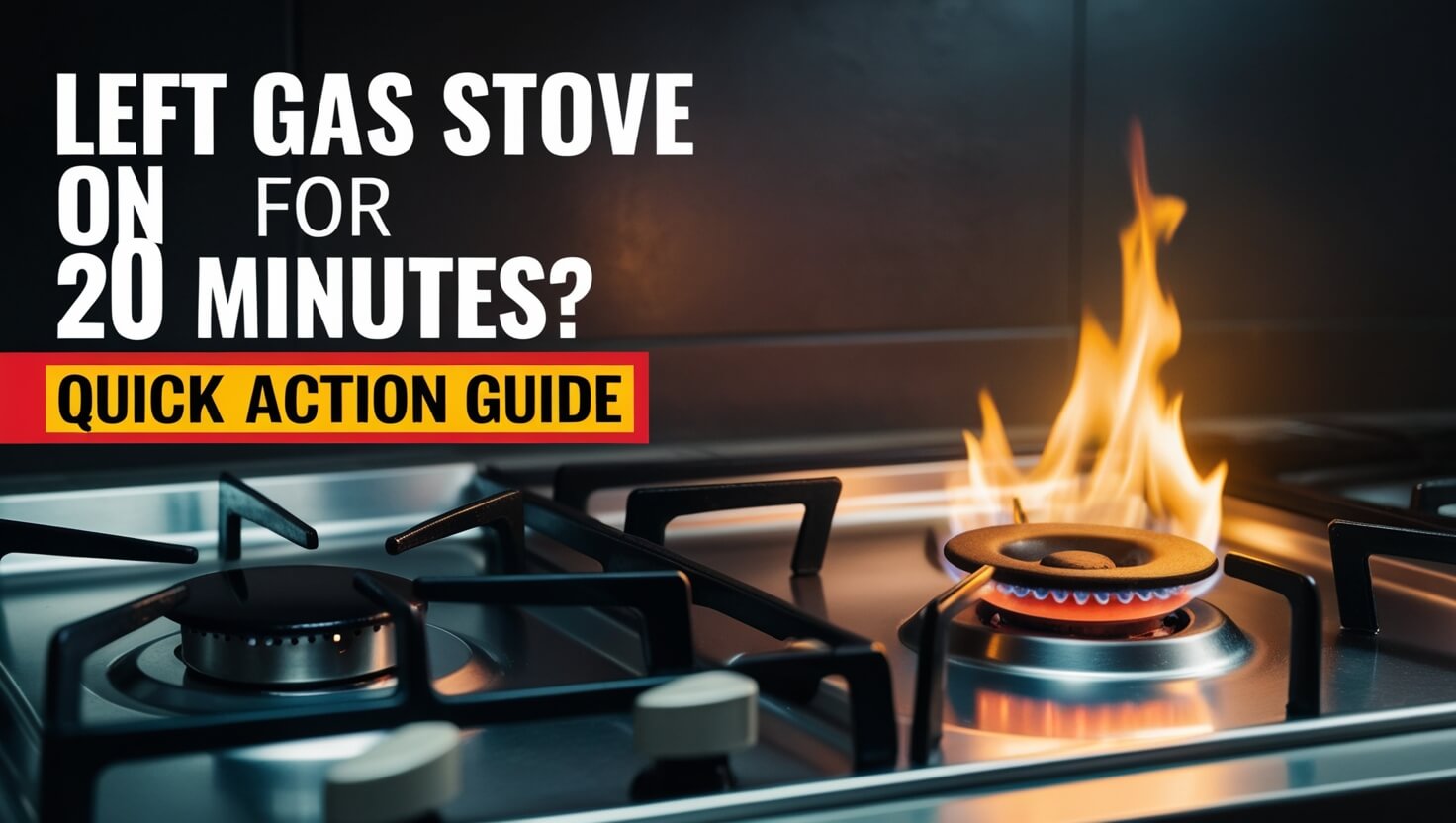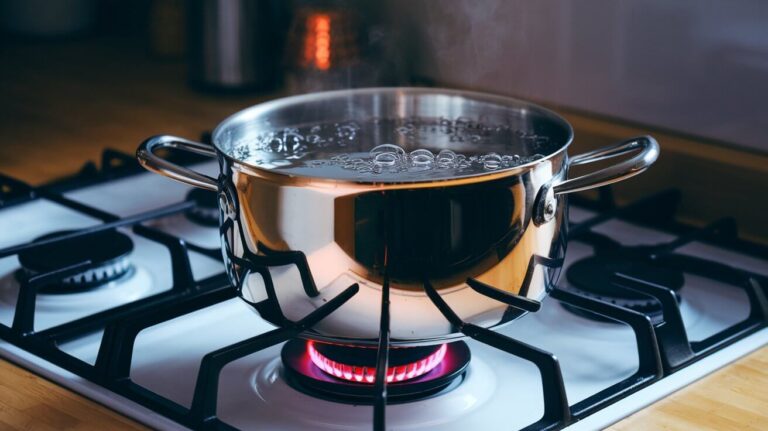
If you’ve accidentally left your gas stove on for 20 minutes, immediately turn off the gas, open windows to ventilate, and avoid creating sparks. While this situation can be alarming, quick action and proper safety measures can prevent serious consequences.
Gas stoves are common in many households, providing efficient cooking and precise temperature control. However, they come with inherent risks, especially when left unattended. This article will guide you through the steps to take if you find yourself in this situation, explore potential dangers, and offer prevention tips to keep you and your loved ones safe.
Immediate Steps to Take
When you realize you’ve left the gas stove on, it’s crucial to act quickly and calmly. Here’s what you should do:
Turn off the gas supply
First things first: shut off the gas. Locate the stove’s control knob and turn it to the “Off” position. If you can’t reach the stove safely, find the main gas shut-off valve for your home and turn it off.
Ventilate the area
Open all windows and doors to allow fresh air in and gas to disperse. If you have exhaust fans, turn them on to help remove the gas. Don’t rely on air conditioning systems, as they can create sparks.
Avoid creating sparks
Don’t flip any light switches, unplug appliances, or use your phone in the affected area. Sparks can ignite accumulated gas, leading to explosions.
Assessing the Situation
After taking immediate action, it’s time to evaluate the severity of the situation.
Checking for gas odors
Natural gas has a distinct rotten egg smell due to added odorants. If you notice this smell, it indicates gas is present. However, don’t rely solely on your nose – some people have a reduced ability to smell gas.
Signs of gas exposure
Watch for symptoms like:
- Dizziness
- Nausea
- Headaches
- Difficulty breathing
- Eye and throat irritation
If you or anyone in your household experiences these symptoms, seek fresh air immediately.
When to evacuate
If the gas smell is strong or persistent, evacuate your home immediately. Don’t wait to see if it clears up – your safety is paramount.
Potential Risks and Dangers
Understanding the risks associated with leaving a gas stove on can help you appreciate the importance of quick action and prevention.
Gas accumulation and explosion hazards
Natural gas can accumulate quickly in enclosed spaces. When mixed with air at certain concentrations, it becomes highly flammable. A single spark can trigger an explosion, causing severe damage and injuries.
Health effects of gas exposure
Breathing in natural gas can lead to various health issues:
- Oxygen deprivation
- Carbon monoxide poisoning (if the gas partially combusts)
- Respiratory problems
- Long-term neurological effects
Long-term consequences
Extended exposure to gas leaks can damage your health and property. It may corrode pipes and appliances, leading to more severe leaks in the future.
Safety Features in Modern Gas Stoves
Today’s gas stoves often come equipped with safety features to prevent accidents. Understanding these can help you choose a safer appliance and use it correctly.
Automatic shut-off mechanisms
Many modern stoves have sensors that detect when a flame goes out and automatically shut off the gas supply. This feature can prevent gas from flowing if the flame is extinguished accidentally.
Flame failure devices
These devices cut off the gas supply if they don’t detect a flame, reducing the risk of gas leaks.
Gas detectors and alarms
While not built into stoves, installing gas detectors in your kitchen can provide an early warning system for leaks.
Preventing Future Incidents
Taking proactive steps can significantly reduce the risk of leaving your gas stove on unattended.
Regular maintenance checks
Schedule annual inspections with a qualified technician. They can identify potential issues before they become dangerous.
Proper usage techniques
Follow these best practices:
- Always stay in the kitchen while cooking
- Use a timer as a reminder
- Double-check that burners are off before leaving the kitchen
- Teach all household members proper stove operation
Installing safety devices
Consider adding these safety measures:
- Gas detectors near your stove
- Stove guards to prevent accidental ignition
- Smart stove shut-off devices
What Not to Do When You’ve Left the Gas On
Knowing what to avoid is just as important as knowing what to do in this situation.
Common mistakes to avoid
Don’t make these errors:
- Lighting matches or candles to check for gas
- Using electrical appliances in the affected area
- Assuming the situation is safe without proper assessment
Actions that increase risk
Avoid these dangerous actions:
- Trying to locate the leak yourself
- Staying in the house if you smell gas
- Ignoring symptoms of gas exposure
When to Seek Professional Help
Sometimes, it’s best to call in the experts.
Calling the gas company
If you can’t locate the source of the leak or the smell persists after ventilation, contact your gas company. They have specialized equipment to detect and address leaks.
Contacting emergency services
Don’t hesitate to call 911 if:
- You smell gas and can’t ventilate safely
- Anyone shows symptoms of gas exposure
- You suspect a major leak
Professional inspection after an incident
Even if you’ve addressed the immediate issue, it’s wise to have a professional inspect your stove and gas lines to ensure everything is safe.
Understanding Gas Stove Mechanics
A basic understanding of how gas stoves work can help you use them more safely.
How gas stoves work
Gas stoves use natural gas or propane as fuel. When you turn the knob, it opens a valve, allowing gas to flow. A spark ignites the gas, creating a flame for cooking.
Types of gases used in stoves
Most home stoves use either:
- Natural gas (methane)
- Propane (LPG)
Each has different properties and safety considerations.
Gas Safety in the Home
Gas safety extends beyond your stove. Here are some general tips to keep your home safe.
General gas safety tips
Follow these guidelines:
- Know where your main gas shut-off valve is located
- Keep the area around gas appliances clear
- Never use gas appliances for heating living spaces
- Install carbon monoxide detectors
Educating family members
Ensure everyone in your household knows:
- How to recognize the smell of gas
- What to do if they smell gas
- How to operate gas appliances safely
Myths and Facts About Gas Stove Safety
Misconceptions about gas safety can be dangerous. Let’s separate fact from fiction.
Debunking common misconceptions
Myth: You can always smell a gas leak. Fact: While gas companies add odorants, some people can’t detect the smell.
Myth: Gas leaks always lead to explosions. Fact: While explosions can occur, many leaks are detected and addressed safely.
Scientific facts about gas exposure
- Natural gas is lighter than air and rises
- Gas needs to mix with air at specific concentrations to become explosive
- Prolonged exposure to even low levels of gas can have health effects
Legal and Insurance Considerations
Understanding the legal and financial aspects of gas incidents is important for homeowners and renters alike.
Liability issues
If a gas incident causes damage to neighboring properties, you could be held liable. Regular maintenance and proper use can help prevent such scenarios.
Insurance coverage for gas-related incidents
Check your homeowners or renters insurance policy to understand what’s covered in case of a gas-related incident. Some policies may require additional riders for full coverage.
Alternatives to Gas Stoves
If you’re concerned about gas safety, consider these alternatives:
Electric and induction cooktops
These options eliminate gas-related risks but come with their own considerations:
- Electric stoves: Slower to heat up and cool down
- Induction cooktops: Fast and efficient, but require specific cookware
Pros and cons of different cooking methods
Each cooking method has its advantages and drawbacks:
- Gas: Precise control, but potential safety risks
- Electric: No gas concerns, but less responsive
- Induction: Efficient and safe, but more expensive
Conclusion: Staying Vigilant with Gas Appliance Safety
Leaving a gas stove on for 20 minutes can be scary, but with quick action and proper knowledge, you can handle the situation safely. Remember to turn off the gas, ventilate the area, and avoid creating sparks. Regular maintenance, proper usage, and awareness of safety features can prevent most gas-related incidents.
By understanding the risks, taking preventive measures, and knowing how to respond in emergencies, you can enjoy the benefits of your gas stove while keeping your home and family safe. Stay alert, follow safety guidelines, and don’t hesitate to seek professional help when needed. With these practices in place, you can cook with confidence and peace of mind.






